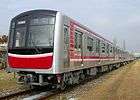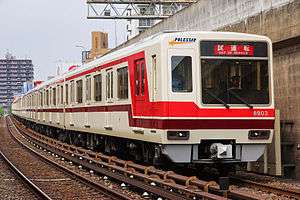Midōsuji Line
| Midōsuji Line | |||
|---|---|---|---|
|
| |||
|
Midōsuji Line 21 series train with red line | |||
| Overview | |||
| Type | Rapid transit | ||
| System | Osaka Municipal Subway | ||
| Locale | Osaka | ||
| Termini |
Esaka Nakamozu | ||
| Stations | 20 | ||
| Line number | 1 | ||
| Operation | |||
| Opened | May 20, 1933 | ||
| Owner | Osaka Municipal Transportation Bureau | ||
| Depot(s) | Nagai, Nakamozu | ||
| Rolling stock | 10 series, 21 series, 30000 series | ||
| Technical | |||
| Line length | 24.5 km (15.2 mi) | ||
| Track length | 24.5 km (15.2 mi) | ||
| Track gauge | 1,435 mm (4 ft 8 1⁄2 in) | ||
| Electrification | 750 V DC, third rail | ||
| Operating speed | 70 km/h (43 mph) | ||
| |||
The Midōsuji Line (御堂筋線 Midōsuji-sen) is a rapid transit line in Osaka, Japan, operated by the Osaka Municipal Subway. Constructed under Midōsuji, a major north-south street, it is the oldest line in the Osaka subway system and the second oldest in Japan, following the Tokyo Metro Ginza Line. Its official name is Rapid Electric Tramway Line No. 1 (高速電気軌道第1号線), while the Osaka Municipal Transportation Bureau refers to it as Osaka City Rapid Railway Line No. 1 (大阪市高速鉄道第1号線), and in MLIT publications it is referred to as Line No. 1 (Midōsuji Line) (1号線(御堂筋線)). On line maps, stations on the Midōsuji Line are indicated with the letter M.
North of Nakatsu it runs above ground in the median of Shin-midōsuji, an elevated freeway.
The section between Senri-chūō and Esaka is owned and operated by Kita-Osaka Kyuko Railway (北大阪急行電鉄 Kita Osaka Dentetsu), but is seamless to the passengers except with respect to fare calculations.
Line data
- Above-ground section: after Nakasu Station to after Momoyama-dai Station
- Block signalling: Automatic
- Train protection system: WS-ATC
- Cars per train: 10 (1996 – present)
- Maximum possible cars per train (platform length): 10
Stations
| No. | Station | Japanese | Distance | Transfers | Location |
|---|---|---|---|---|---|
| ↑ Through-service to/from Senri-Chūō via the Kita-Osaka Kyuko Railway ↑ | |||||
| M11 | Esaka | 江坂 | 0.0 | Kita-Osaka Kyuko Railway | Suita |
| M12 | Higashi-Mikuni | 東三国 | 2.0 | Yodogawa-ku, Osaka | |
| M13 | Shin-Ōsaka | 新大阪 | 2.9 | JR West: | |
| M14 | Nishinakajima- Minamigata |
西中島南方 | 3.6 | Hankyu Railway: Kyoto Main Line (Minamikata) | |
| M15 | Nakatsu | 中津 | 5.4 | Kita-ku, Osaka | |
| M16 | Umeda | 梅田 | 6.4 |
| |
| M17 | Yodoyabashi (Osaka City Hall) |
淀屋橋 (市役所前) |
7.7 | Keihan Railway: Main Line, Nakanoshima Line - Oebashi | Chūō-ku, Osaka |
| M18 | Hommachi (Semba-nishi) |
本町 (船場西) |
8.6 |
| |
| M19 | Shinsaibashi | 心斎橋 | 9.6 |
| |
| M20 | Namba | 難波 | 10.5 |
| |
| M21 | Daikokuchō | 大国町 | 11.7 | |
Naniwa-ku, Osaka |
| M22 | Dōbutsuen-mae (Shinsekai) |
動物園前 (新世界) |
12.9 |
|
Nishinari-ku, Osaka |
| M23 | Tennōji | 天王寺 | 13.9 |
|
Abeno-ku, Osaka |
| M24 | Shōwachō | 昭和町 | 15.7 | ||
| M25 | Nishitanabe | 西田辺 | 17.0 | ||
| M26 | Nagai | 長居 | 18.3 | JR West: Hanwa Line | Sumiyoshi-ku, Osaka |
| M27 | Abiko | 我孫子 | 19.5 | ||
| M28 | Kitahanada | 北花田 | 21.4 | Kita-ku, Sakai | |
| M29 | Shinkanaoka | 新金岡 | 23.0 | ||
| M30 | Nakamozu | 中百舌鳥 | 24.5 |
| |
Rolling stock
- 10/10A series (since 1976/1979) (10 series were transferred from Tanimachi Line)
- 21 series (since 1991)
- 30000 series (since 10 December 2011)
- Kita-Osaka Kyuko 8000 series (since 1987)
- Kita-Osaka Kyuko 9000 series (since 28 April 2014)
 Midōsuji Line 10 series EMU, February 2004
Midōsuji Line 10 series EMU, February 2004 Midōsuji Line 10-car 30000 series EMU, September 2011
Midōsuji Line 10-car 30000 series EMU, September 2011 Kita-Osaka Kyuko 8000 series, August 2013
Kita-Osaka Kyuko 8000 series, August 2013- Kita-Osaka Kyuko 9000 series, May 2014
Former
- 100 series (1933–1969)
- 200 series (1935–1969)
- 300 series (1938–1969)
- 400 series (1943–1969)
- 500 series (1949–1969)
- 600 series (1951–1969)
- 1000 series (1953–1969)
- 1100 series (1957–1969)
- 1200 series (1958–1969)
- 50 series (1960–1969)
- 30 series (1968–1993)
- Kitakyū 7000/8000 series (1969–1970)
- Kitakyū 2000 series (1969–1993)
 A preserved 100 series car, November 2006
A preserved 100 series car, November 2006 30 series on the Midōsuji Line, c.1987
30 series on the Midōsuji Line, c.1987
History
The Midōsuji Line was the first subway line in Osaka and the first government-operated subway line in Japan. Its construction was partly an effort to give work to the many unemployed people in Osaka during the early 1930s. The initial tunnel from Umeda to Shinsaibashi, dug entirely by hand, opened in 1933 after being initially plagued by cave-ins and water leakage caused by the poor composition of the earth below northern Osaka and the equally poor engineering skills of the work crew. The first cars were hauled onto the line by manpower and pack animals from the National Railway tracks near Umeda.
Although the line only operated with single cars at first, its stations were designed from the outset to handle trains of up to eight cars. The line was gradually extended over the next few decades, completing its current length in 1987, making it the second-longest subway line in Osaka after the Tanimachi Line (excluding the Kita-Osaka Kyūkō Railway extension of the Midōsuji Line).
- May 20, 1933 - Umeda (temporary station) - Shinsaibashi (opening).[1] Trains started running in single car formation.
- October 6, 1935 - Umeda Station (present station) opened.
- October 30, 1935 - Shinsaibashi - Namba (opening). Trains started running in 2-car formation.
- April 21, 1938 - Namba - Tennōji (opening). Trains started running in 3-car formation.
- Construction stopped during World War II.
- December 20, 1951 - Tennōji - Shōwachō (opening)
- October 5, 1952 - Shōwachō - Nishitanabe (opening)
- August 1, 1953 - Trains started running in 4-car formation.
- April 1, 1957 - Trains started running in 5-car formation.
- May 1, 1958 - Trains started running in 6-car formation.
- July 1, 1960 - Nishitanabe - Abiko (opening)
- June 1, 1963 - Trains started running in 8-car formation.
- September 1, 1964 - Umeda - Shin-Osaka (opening)
- August 29, 1968 - 30 series EMUs began operation.
- February 24, 1970 - Shin-Osaka - Esaka together with Kita-Osaka Kyuko Railway (Kitakyu) (opening). This section of track was the first in the Midōsuji Line to utilize Automatic Train Control instead of Automatic Train Stop.
- April 1, 1971 - Centralized traffic control introduced.
- February 16, 1976 - 10 series EMUs begin operation.
- April 18, 1987 - Abiko - Nakamozu (opening). Refurbishment of stations to accommodate 9-car trainsets began.
- August 24, 1987, Refurbishment of stations complete, hence all trains were regrouped into 9-car formation.
- May 14, 1991 - 21 series EMUs begin operation.
- 1993 - All trains on the Midōsuji Line are fully air-conditioned after the withdrawal of the 30 series and the Kitakyū 2000 series the same year.
- December 9, 1995 - Refurbishment of stations to accommodate 10-car trainsets began.
- September 1, 1996 - Refurbishment of stations completed, hence all trains were regrouped into 10-car formation.
- November 11, 2002 - Women-only cars were introduced.
- December 2011 - 30000 series trains entered service
References
- ↑ "公営地下鉄在籍車数ビッグ3 大阪市交通局 (One of the big three public subway operators: Osaka Municipal Subway)". Japan Railfan Magazine. Vol. 49 no. 576. April 2009. pp. 88–99.
External links
![]() Media related to Midōsuji Line at Wikimedia Commons
Media related to Midōsuji Line at Wikimedia Commons

